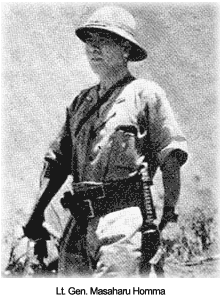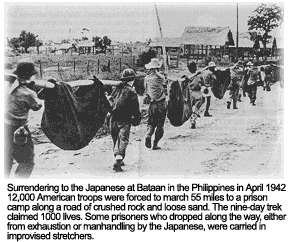The Bataan* Death March began as a plea for life. Men were tired, weak, and lacking food. The 70-mile march from Mariveles (on the tip of Bataan) to San Fernando was a trial that tested a man, broke him, or got him killed. The famished men who made the exhausting march in World War II would never be forgotten.
On April 9, 1942, American and Filipino troops on the Bataan Peninsula on West Luzon Island in the Philippines decided that they would not survive much longer in their fight against the Japanese. They were low on food, ammunition, and morale, and men were dying from lack of nourishment more than enemy fire. In the afternoon of the 9th, they turned themselves over to the Japanese by raising white flags, T-shirts, and whatever other white articles they had to let them know they were finished with fighting.
 When Lt. General Masahuro Homma took the soldiers prisoner, he discovered that there were many more men than he had anticipated, and he was unable to transport all of them by truck to the prison camp in San Fernando. The only way to get the men to the camp was to make them march the 70 miles. The Japanese High Command advised him that it should only require a few days, but the men taken as prisoners of war were not in good health and were malnourished. That set the stage for an onslaught of inexcusable brutality.
By that time, the Japanese were flush with victory over the foreign meddlers they had been contending with for so many years, and were ready to show that they were the superior power in Asia. They committed random beatings and killings of all kinds. They killed men without provocation, or if a guard felt that someone had looked at him the wrong way, he was at liberty to bayonet him to death. If a prisoner was found with a souvenir, he was shot immediately because his executioners assumed that the only way to obtain such an item was to kill a Japanese soldier.
When Lt. General Masahuro Homma took the soldiers prisoner, he discovered that there were many more men than he had anticipated, and he was unable to transport all of them by truck to the prison camp in San Fernando. The only way to get the men to the camp was to make them march the 70 miles. The Japanese High Command advised him that it should only require a few days, but the men taken as prisoners of war were not in good health and were malnourished. That set the stage for an onslaught of inexcusable brutality.
By that time, the Japanese were flush with victory over the foreign meddlers they had been contending with for so many years, and were ready to show that they were the superior power in Asia. They committed random beatings and killings of all kinds. They killed men without provocation, or if a guard felt that someone had looked at him the wrong way, he was at liberty to bayonet him to death. If a prisoner was found with a souvenir, he was shot immediately because his executioners assumed that the only way to obtain such an item was to kill a Japanese soldier.
 At one point, 30 POWs attempted to fill their canteens on the side of the road. That was not what the Japanese had in mind. As the men were filling their canteens, the Japanese set up machine guns and shot them on the spot. Other men were allowed to get water, but when they got to it, it was filled with maggots. That was pure torture because there were water spigots nearby with clean water. Anyone who tried to drink water who was not allowed to, was shot. When the men were allowed to rest, they were forced down on burning hot pavement, and those who fell behind even a few yards were bayoneted and shot.
In 1946, General Homma was held responsible for the brutal treatment of the soldiers. He was tried, convicted, and executed that same year. Testimonies of the survivors of the incident helped to convict the general of his war crimes.
At one point, 30 POWs attempted to fill their canteens on the side of the road. That was not what the Japanese had in mind. As the men were filling their canteens, the Japanese set up machine guns and shot them on the spot. Other men were allowed to get water, but when they got to it, it was filled with maggots. That was pure torture because there were water spigots nearby with clean water. Anyone who tried to drink water who was not allowed to, was shot. When the men were allowed to rest, they were forced down on burning hot pavement, and those who fell behind even a few yards were bayoneted and shot.
In 1946, General Homma was held responsible for the brutal treatment of the soldiers. He was tried, convicted, and executed that same year. Testimonies of the survivors of the incident helped to convict the general of his war crimes.